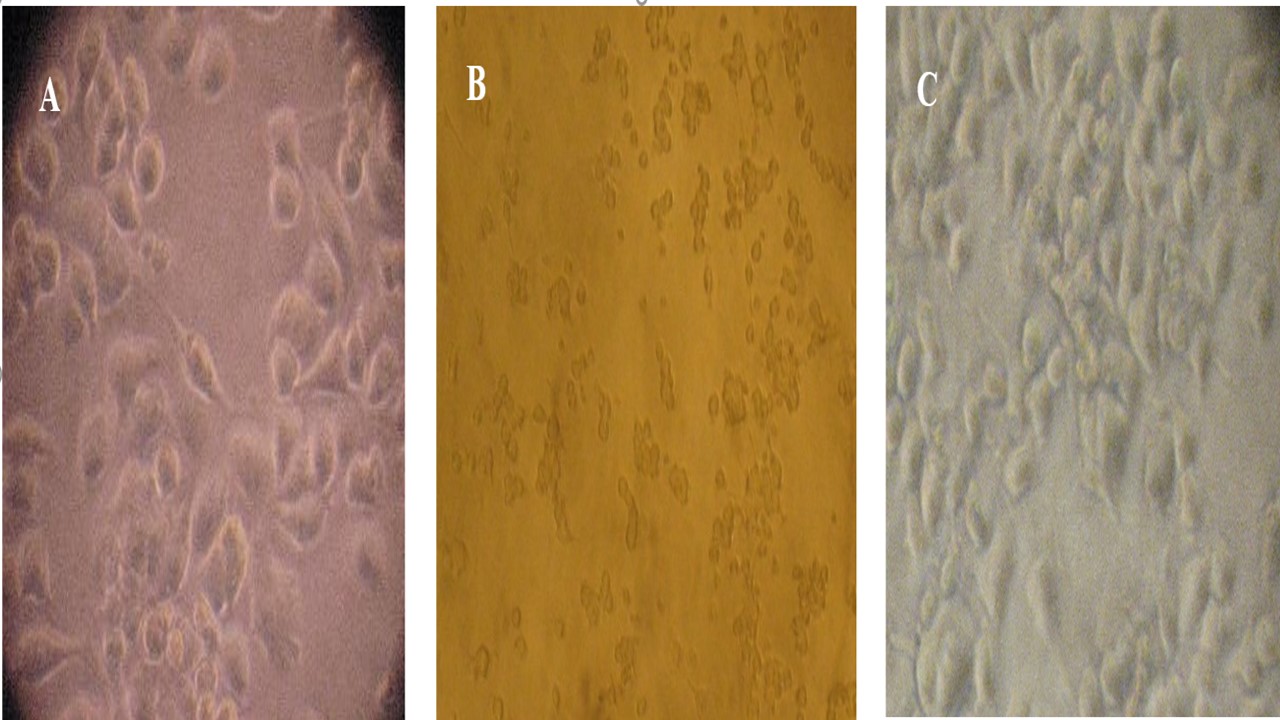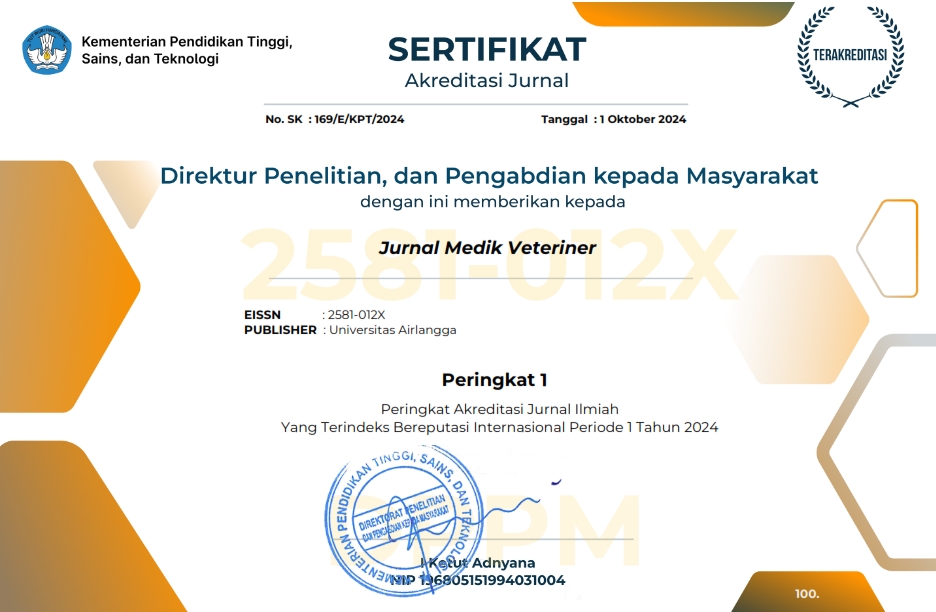Adaptation of African Swine Virus in Non-Swine Cell Lines: A Preliminary Study for Vaccine Candidate

Downloads
African Swine Fever (ASF) is among the most detrimental infectious viral diseases in pigs causing approximately 100% mortality. The disease was first reported about 83 years ago in Africa before spreading to Europe in 1957 and Asia in 2010. An adequate vaccine generally containing live attenuated virus isolates prepared in swine macrophages to control the disease is currently unavailable. Therefore, this study aimed to use murine neuroblastoma (N2a) cells, non-swine cell lines, to adapt African swine fever virus (ASFV) isolates for vaccine preparation. ASFV isolate called BL21 obtained from Bali and East Nusa Tenggara was previously propagated in swine macrophages. However, virus was currently adapted in the N2a cells to avoid unwanted issues associated with using swine macrophages, including microbial contamination, as well as technically laborious and ethical issues. The adapted BL21 was re-confirmed with quantitative polymerase chain reaction (q-PCR) and tested in vivo to examine the pathogenicity properties. The results showed that BL21 produced consistently and specifically positive q-PCR, killing experimental pigs with typical gross pathological changes of ASF. BL21 at a 10-3/mL dilution adapted in N2a cells showed similar antigenic properties causing the death of nearly 50% N2a cells in vitro and terminating all in vivo experimental pigs. In conclusion, the BL21 isolate reported in this study could be used as a vaccine candidate after more attenuation and particularly to determine a lethal dose of 50% (LD50) for future investigations.
Ackerman, D., & Robinson, L. (2022). African swine fever virus Research Review. STAR-IDAZ International Research Consortium on Animal Health (727494), London, pp: 1–160.
Arokium, H., Kamata, M., & Chen, I. (2009). Virion-associated VPR of human immunodeficiency virus type 1 Triggers activation of apoptotic events and enhances fas-induced apoptosis in human T cells. Journal of Virology, 83(21), 11283–11297.
Blome, S., Franzke, K., & Beer, M. (2020). African swine fever – A review of current knowledge. Virus Research, 287(4), 198099.
Borca, M. V., Rai, A., Ramirez-Medina, E., Silva, E., Velazquez-Salinas, L., Vuono, E., Pruitt, S., Espinoza, N., & Gladue, D. P. (2021). A cell culture-adapted vaccine virus against the current african swine fever virus pandemic strain. Journal of Virology, 95(14), e0012321.
Borca, V. M., Rai, A., Espinoza, N., Ramirez-Medina, E., Spinard, E., Velazquez-Salinas, L., Valladares, A., Silva, E., Burton, L., Meyers, A., Gay, C. G., & Gladue, D. P. (2023). African swine fever vaccine candidate ASFV-G-ΔI177L produced in the swine macrophage-derived cell line ipkm remains genetically stable and protective against homologous virulent challeng. Viruses, 15(10), 2064.
Bulu, P. M., Paga, A., Lasakar, A. S., & Wera, E. (2023). Pig Farm Management and Its Contribution to The African Swine Fever Incidences in Kupang, Indonesia. Jurnal Medik Veteriner, 6(2), 155–161.
Cao, H., Zhang, M., Liao, Z., Dongfan., He, X., Ma, H., Li, P., Yu, X., Peng, G., Xie, S., He, Q., & Li, W. (2024). A porcine kidney-derived clonal cell line with clear genetic annotation is highly susceptible to African swine fever virus. Veterinary Research, 55, 42.
Chathuranga, K., & Lee, J. S. (2023). African swine fever virus (ASFV): Immunity and vaccine development. Vaccines, 11(2), 199.
Cook, S. J., Cook, R. F., Montelaro, R. C., & Issel, C. J. (2001). Differential responses of Equus caballus and Equus asinus to infection with two pathogenic strains of equine infectious anemia virus. Veterinary Microbiology, 79(2), 93–109.
Cwynar, P., Stojkov, J., & Wlazlak, K. (2019). African swine fever status in Europe. Viruses, 11(4), 310.
Desport, M., Tenaya, I. W. M., McLachlan, A., McNab, T. J., Rachmat, J., Hartaningsih, N., & Wilcox, G. E. (2009). In vivo infection of IgG-containing cells by jembrana disease virus during acute infection. Virology, 393(2), 221–227.
Dharmayanti, N. L. P. I., Sendow, I., Ratnawati, A., Settypalli, T. B. K., Saepulloh, M., Dundon, W. G., Nuradji, H., Naletoski, I., Cattoli, G., & Lamien, C. E. (2021). African swine fever in North Sumatra and West Java provinces in 2019 and 2020, Indonesia. Transboundary and Emerging Diseases, 68(5), 2890–2896.
Dixon, L. K., Stahl, K., Jori, F., Vial, L., & Pfeiffer, Di. U. (2020). African swine fever epidemiology and control. Annual Review of Animal Biosciences, 8, 221–246.
FAO. (2022). African swine fever (ASF) situation update in Asia and Pacific. Food and Agriculture Organization of the United Nation-Animal Health.
Forth, J. H., Calvelage, S., Fischer, M., Hellert, J., Sehl-Ewert, J., Roszyk, H., Deutschmann, P., Reichold, A., Lange, M., Thulke, H. H., Sauter-Louis, C., Hoper, D., Mandyhra, S., Sapachova, M, Beer, M., Blome, S. (2023). African swine fever virus - variants on the rise. Emerging Microbes and Infectious, 12, 2146537.
Franzoni, G. (2022). Cell Lines for the Development of African Swine Fever Virus Vaccine Candidates : An Update. Vaccines, 10, 707.
Ji, J., Chen, J. J., Braciale, V. L., & Cloyd, M. W. (2007). Apoptosis induced in HIV-1-exposed, resting CD4 ϩ T cells subsequent to signaling through homing receptors is Fas/Fas ligand-mediated. Journal of Leukocyte Biology, 81(1), 297–305.
Kementan. (2020). Indonesia confirms african swine fever outbreak. Report Highlights. Ministry of Agriculture, Republic of Indonesia.
King, D. P., Reid, S. M., Hutchings, G. H., Grierson, S. S., Wilkinson, P. J., Dixon, L. K., Bastos, A. D., & Drew, T. W. (2003). Development of a TaqMan PCR assay with internal amplification control for the detection of african swine fever virus. Journal of Virological Methods, 107(1), 53–61.
Li, S., Xu, B., Luo, Y., Luo, J., Huang, S., & Guo, X. (2024). Autophagy and apoptosis in rabies virus replication. Cells, 13(2), 183.
Liu, Y., Xie, Z., Li, Y., Song, Y., Di, D., Liu, J., Gong, L., Chen, Z., Wu, J., Ye, Z., Liu, J., Yu, W., Lv, L., Zhong, Q., Tian, C., Song, Q., Wang, H., & Chen, H. (2023). Evaluation of an I177L gene-based fve-gene-deleted african swine fever virus as a live attenuated vaccine in pigs. Emerging Microbes and Infectious, 12, 2148560.
Montgomery, R. E. (1921). On a form of swine fever occurring in British East Africa (Kenya Colony). Journal of Comparative Pathology and Therapeutics, 34, 159–191.
Montoya, M., Franzoni, G., Revilla, Y., Galindo, I., & Alonso, C. (2021). Understanding and combatting african swine fever. A European perspective. Brill publishing, pp: 63–85.
Muñoz-Pérez, C., Jurado, C., & Sánchez-Vizcaíno, J. M. (2021). African swine fever vaccine: Turning a dream into reality. Tranboundry and Emerging Diseases, 68(5), 2657–2668.
Murakami, K., Sentsui, H., Shibahara, T., & Yokoyama, T. (1999). Reduction of CD4+ and CD8+ T lymphocytes during febrile periods in horses experimentally infected with equine infectious anemia virus. Veterinary Immunology and Immunopathology, 67(2), 131–140.
Noviantari, A., & Khariri, K. (2020). Cell culture as the most certain way of diagnosis in rabies infection. International Conference on Agromedicine and Tropical Diseases, 3(1), 21.
Purnama, M. T. E., Prayoga, S. F., Triana, N. M., Dewi, W. K., Purnomoaji, B. S., Wardhana, D. K., & Fikri, F. (2020). Oxidative stress parameters in landrace pigs slaughtered by the stunning method. In IOP Conference Series: Earth and Environmental Science, 441(1), 012140. IOP Publishing.
Ruiz-Saenz, J., Diaz, A., Bonilla-Aldana, D. K., Rodríguez-Morales, A. J., Martinez-Gutierrez, M., & Aguilar, P. V. (2022). African swine fever virus: A re-emerging threat to the swine industry and food security in the Americas. Frontiers in Microbiology, 13, 1011891.
Segeritz, C. P., & Vallier, L. (2020). Cell culutre: Growing cells as model systems in vitro. Basic Science Methods for Clinical Researchers, Academic Press, pp: 151–172.
Tenaya, I. W. M., Heel, K., Stumbles, P. A., & Wilcox, G. E. (2012). Flow cytometric analysis of lymphocyte subset kinetics in Bali cattle experimentally infected with Jembrana disease virus. Veterinary Immunology and Immunopathology, 149(3–4), 167–176.
Tenaya, I. W. M., Suartha, N., Suarsana, N., Damriyasa, M., Apsasi, I. A. P., Sari, T. K., Agustini, L. P., Miswati, Y., & Agustina, K. K. (2023a). Epidemiological and viral studies of rabies in Bali, Indonesia. Veterinary World, 16, 2446–2450.
Tenaya, I. W. M., Swacita, I. B. N., Wirata, K., Damriyasa, M., Besung, N. K., Suarsana, N., Sari, T. K., & Agustina, K. K. (2023b). A study of African swine fever virus in Regional VI of the Disease Investigation Center of Denpasar Bali in Indonesia. Veterinary World, 16, 844–850.
WOAH. (2023). African Swine Fever. Disease. World Organization for Animal Health.
Yamada, M., Masujin, K., Kameyama, K. I., Yamazoe, R., Kubo, T., Iwata, K., Tamura, A., Hibi, H., Shiratori, T., Koizumi, S., Ohashi, K., Ikezawa, M., Kokuho, T., & Yamakawa, M. (2020). Experimental infection of pigs with different doses of the african swine fever virus armenia 07 strain by intramuscular injection and direct contact. Journal of Veterinary Medical Science, 82(12), 1835–1845.
Zhao, J., Zeng, Z., Chen, Y., Liu, W., Chen, H., Fu, Z. F., Zhao, L., & Zhou, M. (2022). Lipid droplets are beneficial for rabies virus replication by facilitating viral budding. Journal of Virology, 96(2), 1–19.
Zheng, W., Xi, J., Zi, Y., Wang, J., Chi, Y., Chen, M., Zou, Q., Tang, C., & Zhou, X. (2023). Stability of african swine fever virus genome under different environmental conditions. Veterinary World, 16, 2374–2381.
Copyright (c) 2025 I Wayan Masa Tenaya, Kadek Karang Agustina, I Ketut Suada, Ida Ayu Pasti Apsari, Tri Komala Sari, Ni Made Handayani, Anak Agung Ayu Sauca Sunia Widayantari, Anak Agung Komang Suardana, I Made Sumarya, I Nyoman Arsana, I Putu Sudiartawan, I Wayan Wahyudi, Ni Ketut Ayu Juliasih, Ni Luh Gede Sudaryati, I Made Damriyasa

This work is licensed under a Creative Commons Attribution-NonCommercial-ShareAlike 4.0 International License.
Authors who publish in this journal agree to the following terms:
1. The journal allows the author to hold the copyright of the article without restrictions;
2. The journal allows the author(s) to retain publishing rights without restrictions;
3. The legal formal aspect of journal publication accessibility refers to Creative Commons Attribution-NonCommercial-ShareAlike 4.0 International License (CC BY-NC-SA).






11.jpg)




















